|

Part
1 - from
1454 to 1510
Part
2 - from
1512 to 1577
Part
3 - from
1577 to 1618
Part
4 - from
1618 to 1647
Part
5 - from
1648 to 1655
Part
6 - from 1655 to 1660
Part
7 - from
1660 to 1672
Part
8 - from
1672 to 1699
|
|
1454
to 1510
(links to map of Poland)
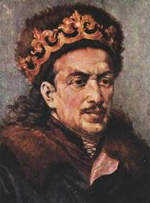 At
the beginning of our period the King of Poland was Kazimierz IV
(Casimir) Jagiello who was crowned in 1447 and succeeded the young
Wladyslaw Jagiello who had fallen at Varna against the Ottomans. At
the beginning of our period the King of Poland was Kazimierz IV
(Casimir) Jagiello who was crowned in 1447 and succeeded the young
Wladyslaw Jagiello who had fallen at Varna against the Ottomans.
1454-1466
The Thirteen Years War
In 1440 the nobles and towns of the Teutonic
Order formed the Prussian Union and when support from Poland was
not forthcoming they revolted against the Order. The wealthy city
of Torun led the way followed by Gdansk, Elbing and Konigsberg and
soon only the Order's Capital Malbork (Marienburg), Stum and Chojnice
remained in the Order. In February 1454 King Kazimierz incorporated
Prussia into Poland promising the inhabitants equal rights with
the Poles. Poland thought that the decaying Order would not require
too much effort to defeat.
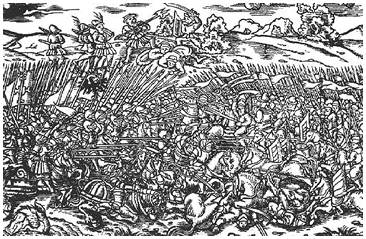 The
King crossed the frontier and was greeted enthusiastically by the
Prussian union towns and with their small forces Stum was taken
and Malbork, a formidable fortress, besieged. Chojnice remained
a strategic link between Prussia and Germany and the Order hired
8,000 mercenaries to save the vital town. Led by professional generals
they were more than a match for the small Polish forces, so Kazimierz
called-up the noble levy of Greater Poland. These nobles extracted
various rights from the Crown before they would agree to fight.
They advanced, without assistance from the small regular forces,
and on 9th September 1454 the ill disciplined force of 16,000 met
15,000 Teutonic Knights and a decisive defeat at Chojnice
(18 September 1454), with the King only just escaping capture. The
King crossed the frontier and was greeted enthusiastically by the
Prussian union towns and with their small forces Stum was taken
and Malbork, a formidable fortress, besieged. Chojnice remained
a strategic link between Prussia and Germany and the Order hired
8,000 mercenaries to save the vital town. Led by professional generals
they were more than a match for the small Polish forces, so Kazimierz
called-up the noble levy of Greater Poland. These nobles extracted
various rights from the Crown before they would agree to fight.
They advanced, without assistance from the small regular forces,
and on 9th September 1454 the ill disciplined force of 16,000 met
15,000 Teutonic Knights and a decisive defeat at Chojnice
(18 September 1454), with the King only just escaping capture.
On the news of the Polish defeat most of the towns
east of the Vistula reverted to the Order, while others wavered.
The noble levy of all of Poland was raised, but proved ineffectual,
and increasing reliance was made on, mainly Czech, mercenaries.
The war took on the character of a contest between professional
armies. Poland continued involvement was mainly due to the stubbornness
of the King and particularly Gdansk's support in its desire to break
the oppressive power of the Order. When Denmark aided the Order
the Gdansk fleet defeated a combined Danish-Teutonic squadron off
the island of Bornholm in 1456. Malbork was bought off the mercenary
leader holding it while the Prussian lands were devastated.
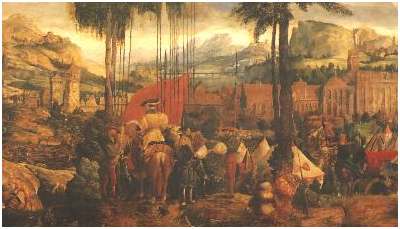 In
1462 Gdansk was relieved by an able commander Piotr Dunin, who with
2,000 troops defeated 2,700 men of the Order at Swiecino
near Puck on 17th August. This proved to be the turning point.
In 1463 the Order's fleet of 44 ships met defeat off Elbing at the
mouth
of the Vistula (15 September 1463),
by 25 ships of the combined Gdansk-Elbing fleet, while Dunin captured
Gniew. The leader of the Order's mercenaries turned neutral, while
a year later the Bishop of Warmia joined the Union. Finally in 1466
Staragard and Chojnice were captured by Dunin and other forces cleared
Pomerania of the enemy. Surrender for the Order became inevitable
and in the Peace of Torun (19 October 1466) the Order lost its independence,
the Grand Master became a Vassal to the Crown, retaining Eastern
Prussia (called Ducal Prussia). After a century of foreign domination
Pomerania was recovered. In
1462 Gdansk was relieved by an able commander Piotr Dunin, who with
2,000 troops defeated 2,700 men of the Order at Swiecino
near Puck on 17th August. This proved to be the turning point.
In 1463 the Order's fleet of 44 ships met defeat off Elbing at the
mouth
of the Vistula (15 September 1463),
by 25 ships of the combined Gdansk-Elbing fleet, while Dunin captured
Gniew. The leader of the Order's mercenaries turned neutral, while
a year later the Bishop of Warmia joined the Union. Finally in 1466
Staragard and Chojnice were captured by Dunin and other forces cleared
Pomerania of the enemy. Surrender for the Order became inevitable
and in the Peace of Torun (19 October 1466) the Order lost its independence,
the Grand Master became a Vassal to the Crown, retaining Eastern
Prussia (called Ducal Prussia). After a century of foreign domination
Pomerania was recovered.
1497
Turkish-Moldavian Expedition
In 1484 the Ottoman Empire tore from Stephen the Great of Moldavia
two strategic ports, Killia at the mouth of the Danube and Akkerman
at the mouth of the Dniestr, and so approached the borders of Poland
and Lithuania. The Crimean Tartars came under Turkish control and
became a scourge to the Ruthenian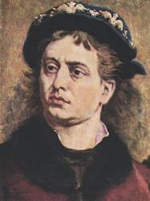 border lands of Poland and Lithuania.
border lands of Poland and Lithuania.
In
1492 King Kazimierz died and was succeeded
by his eldest son Jan Olbracht (John Albert).
In
1497 a major expedition was organised by the new King to the Black
sea with the original intention of recapturing Akkerman and Killia
from the Turks. Some 40,000 troops were involved with 200 hundred
cannon including two great mortars. But Moldavia now answered to
Turkey and the King, though advised by the army's leader to limit
the objective to capturing the Moldavian frontier town of Chocim,
still wanted to strike at the Turks. He turned against Stephen to
protect his flank and besieged the capital,
Suczawa. The siege was unsuccessful (due at least partly to Hungarian
intervention) and a truce was agreed whereby the Polish army would
be afforded an unhampered retreat. However Moldavian forces supported
by Ottoman troops attacked the Poles at Kozmin
in Bokovina defeating them, though with not too great a loss to
the Poles. Without the efforts of the Royal Guard or the later assistance
of Lithuanian Grand Duke Alexander at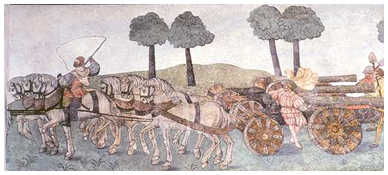 the crossing of the river Prut the situation could have been far
worse. Though the defeat had not been serious and the Truce was
honorable the result was that Tartar and Turkish invasions increased
dramatically.
the crossing of the river Prut the situation could have been far
worse. Though the defeat had not been serious and the Truce was
honorable the result was that Tartar and Turkish invasions increased
dramatically.
In 1498 Poland
suffered two retaliatory attacks from the Ottomans and a smaller
Tartar incursion. Two large Tartar attacks occurred in 1500 and
the following year, until a Truce was agreed with Bajazet II.
1500-1503
War with Muscovy
In
1500 Ivan III was active along the Lithuanian borderlands, capturing
extensive parts of the Ruthenian provinces and destroying
local Lithuanian armies and auxiliary Teutonic forces.
The Lithuanians, allied to the Livonian Master
and the Volga Tartars, did achieve some success but were unable
to regain the lost lands.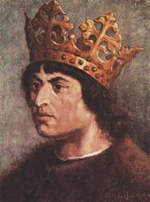
In June
1501 Jan Olbracht died and his brother
Aleksander (Alexander) Jagiello
succeeded him
as King in December 1501.
King Alexander proceeded to Novogrod in July 1502
to find a worsening situation. The 'allied' Volga Tartars had been
routed by the Crimean Tartars and the Muscovites had occupied the
defeated Tartars' lands. Ivan III attacked Smolensk, his main objective.
But in the North the Livonian Order defeated the Muscovites and
relieved Smolensk. In 1503 Ivan III agreed to a six year truce,
giving up on Smolensk but retaining much of the border lands.
1506 Tartar Invasion
Attacks continued by Mengli-Girey of the Crimean Tartars, in Spring
1506 they invaded Lithuania with 10,000 men camping at Kleck,
near Nieswiez, sending forces to Minsk, Nowogrodek and Lida. Glinski,
an experienced commander, was sent with a comparable sized force,
including the new hussars and two canons, smashing the encampment
and routing the whole Tartar army (5 August 1506).
King Alexander died and his brother
King Zygmunt I (Sigismund) Jagiello known as "The Old"
was crowned on 24th January 1507
1507-1508 War
with Muscovy
The Muscovites restarted their expansion westwards when in April
1507 two armies entered Lithuania devastating as far as the Berezyna.
As the Poles and Lithuanians prepared to repulse the attacks Glinski
led a rebellion with assistance from Muscovy. His aim to stir up
the local population failed, and the Glinski-Muscovite forces attempted
to take Minsk, but withdrew to join further Muscovite forces when
the Polish-Lithuanian army approached. The Muscovite force besieged
Orsza, but again retreated in front of the Royal army. The Poles
attacked and Glinski fled. Peace negotiations were concluded in
October 1508 where Moscow conceded Lukecz, but Lithuania recognised
the conquests of Ivan.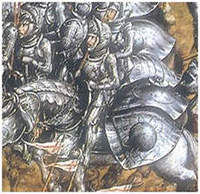
1509-1510 War with Moldavia
Meanwhile Bogdan of Moldavia invaded Pokucie and in June 1509 defeated
a counter attack of the Kamieniec garrison and advanced on Lvov,
however they failed to take any important strongholds and retreated,
plundering as they went. A 4,000 strong force of the pospolite
ruszenie, was sent to Suczam and completely destroyed the
Moldavian army on 4th October 1509 at the Dniestr ford. Peace was
concluded in January 1510 where Moldavia gave back Pokucie as well
as their prisoners and the spoils of war.
1 
|
|

Page
1

|

![]()
 At
the beginning of our period the King of Poland was Kazimierz IV
(Casimir) Jagiello who was crowned in 1447 and succeeded the young
Wladyslaw Jagiello who had fallen at Varna against the Ottomans.
At
the beginning of our period the King of Poland was Kazimierz IV
(Casimir) Jagiello who was crowned in 1447 and succeeded the young
Wladyslaw Jagiello who had fallen at Varna against the Ottomans.

 In
1462 Gdansk was relieved by an able commander Piotr Dunin, who with
2,000 troops defeated 2,700 men of the Order at
In
1462 Gdansk was relieved by an able commander Piotr Dunin, who with
2,000 troops defeated 2,700 men of the Order at 



